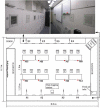Integrated system of exhaust air heat pump and advanced air distribution for energy-efficient provision of outdoor air
- PMID: 36091098
- PMCID: PMC9439866
- DOI: 10.1016/j.applthermaleng.2022.119256
Integrated system of exhaust air heat pump and advanced air distribution for energy-efficient provision of outdoor air
Abstract
A large outdoor air supply is required to control the airborne infection risk of respiratory diseases (e.g., COVID 19) but causes a high energy penalty. This study proposes a novel integrated system of the exhaust air heat pump and advanced air distribution to energy-efficiently provide outdoor air. The system energy performances are evaluated by the experimentally validated thermodynamic model of heat pump and heat removal efficiency model of advanced air distribution. Results show the exhaust air heat pump with advanced air distribution can save energy because of three mechanisms. First, the exhaust air heat pump reuses the exhaust air to reduce the condensation temperature, thereby improving the coefficient of performance. Second, advanced air distribution reduces ventilation load. Third, advanced air distribution reduces the condensation temperature and enhances the evaporation temperature, thereby improving the coefficient of performance. The exhaust air heat pump saves energy by 18%, advanced air distribution saves energy by 36%, and the integrated system of the exhaust air heat pump and advanced air distribution can save energy by 45%. As a specific application, compared with the conventional system (i.e., the outdoor air heat pump with mixing ventilation), the exhaust air heat pump with stratum ventilation saves energy by 21% - 35% under various outdoor air ratios and outdoor air temperatures. The proposed integrated system of the exhaust air heat pump and advanced air distribution contributes to the development of low-carbon and healthy buildings.
Keywords: Advanced air distribution; Exhaust air heat pump; Heat removal efficiency; Outdoor air supply.
© 2022 Elsevier Ltd. All rights reserved.
Conflict of interest statement
The authors declare that they have no known competing financial interests or personal relationships that could have appeared to influence the work reported in this paper.
Figures




















Similar articles
-
Field monitoring data on a residential exhaust air heat pump system (air-to-air heat pump).Data Brief. 2021 Sep 20;38:107386. doi: 10.1016/j.dib.2021.107386. eCollection 2021 Oct. Data Brief. 2021. PMID: 34604479 Free PMC article.
-
Experimental study and performance analysis of solar-driven exhaust air thermoelectric heat pump recovery system.Energy Build. 2019 Mar 1;186:46-55. doi: 10.1016/j.enbuild.2019.01.017. Epub 2019 Jan 22. Energy Build. 2019. PMID: 32288119 Free PMC article.
-
Thermodynamic and thermo-economic analyses of a coupled heat-pump system for low-grade exhaust-air heat exchange in mines.Environ Technol. 2024 Nov;45(25):5318-5331. doi: 10.1080/09593330.2023.2290600. Epub 2023 Dec 12. Environ Technol. 2024. PMID: 38084652
-
A numerical evaluation of a novel recovery fresh air heat pump concept for a generic electric bus.Appl Therm Eng. 2022 Jun 5;209:118181. doi: 10.1016/j.applthermaleng.2022.118181. Epub 2022 Feb 7. Appl Therm Eng. 2022. PMID: 35153534 Free PMC article.
-
Health, work performance, and risk of infection in office-like environments: The role of indoor temperature, air humidity, and ventilation.Int J Hyg Environ Health. 2021 Apr;233:113709. doi: 10.1016/j.ijheh.2021.113709. Epub 2021 Feb 15. Int J Hyg Environ Health. 2021. PMID: 33601136 Review.
Cited by
-
Occupancy-aided ventilation for airborne infection risk control: Continuously or intermittently reduced occupancies?Build Simul. 2023;16(5):733-747. doi: 10.1007/s12273-022-0951-7. Epub 2022 Nov 5. Build Simul. 2023. PMID: 36373145 Free PMC article.
-
Multi-Physical Lattice Metamaterials Enabled by Additive Manufacturing: Design Principles, Interaction Mechanisms, and Multifunctional Applications.Adv Sci (Weinh). 2025 Feb;12(8):e2405835. doi: 10.1002/advs.202405835. Epub 2025 Jan 20. Adv Sci (Weinh). 2025. PMID: 39834122 Free PMC article. Review.
References
-
- Fung T.S., Liu D.X. Human coronavirus: host-pathogen interaction. Annu. Rev. Microbiol. 2019;73:529–557. - PubMed
LinkOut - more resources
Full Text Sources
Research Materials
